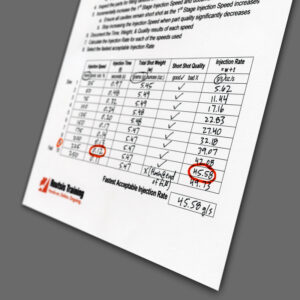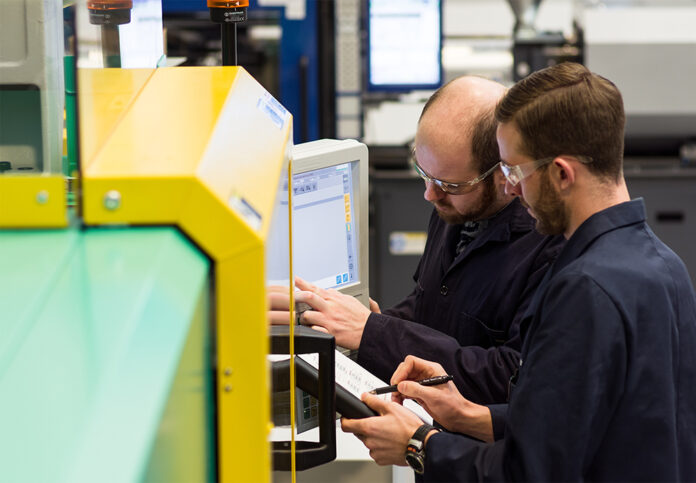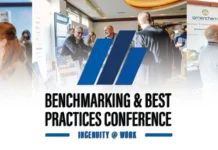By Daniel Stephens, vice president, Routsis Training LLC
In production environments, the most important goal is maintaining “productive uptime.” This means that product is being produced at a rate that is profitable, and the customer base is satisfied with its quality level.
One of the biggest factors that interrupt productive uptime is change. Examples of change can be new product lines, different systems, employee layoffs, new materials, plant expansion, large employee hiring, specialized equipment, damaged equipment, automation and robotics, unexpected downtime, company acquisition, etc. Change is inevitable in a productive environment and no company would survive doing things the same way they did 10 years ago. Routsis Training started out producing VHS tapes over 30 years ago, but we have adapted multiple times; producing laser discs, CD-ROMs and going online in 2007. Today, Routsis Training’s primary business is providing in-house employee development solutions for plastics processors.
Every company that has survived for more than a few years has endured change. Many plastics processors started out decades ago doing something completely different than their current core competence. The key to not only survive but thrive is a company’s ability to handle change and preserve a state of profitability.
A Competent Production Staff
In plastics processing, it always is important to have a very strong and capable front office – from managers and accounting to sales and engineering. They are responsible for identifying and incorporating constant change into the company paradigm. As new challenges come along, these personnel should have the background, experience and knowledgebase to comprehend and adapt, putting those advanced engineering and management degrees to good use.
Handling change does not completely lie in the front office, but in converting these obstacles into productive uptime. This requires operators, inspectors, supervisors and technicians who are knowledgeable and confident enough to properly implement each change. It is both, the strength of the front office as well as the ongoing capability of technical staff that ensures the future profitability of the company. In fact, many companies with competent production staff have remained highly profitable during short periods of engineering and management shortages – the opposite is seldom true, except in very small companies. So, how does a company prepare its production staff for implementing constant change?
Employees Must Have Understanding
For employees to sustain and embrace change, they must have enough knowledge to understand and incorporate changes into their thought processes. If someone has been doing something one way for 10 years, it is not enough to just say, “We’re doing it this way now because it’s better.” Employees should be knowledgeable in the job they are doing, as well as their work environment. Yes, different jobs require different levels of knowledge, but even a packer should have a basic understanding of the machinery and automation they are working around, the product they are handling, customer requirements, associated documentation and even the company they work for. The more they know about their job and work environment, the faster they will be able to accept and implement change.
For example: Let’s suppose there is a new company procedure to tape boxes with at least four inches of tape on each side of the box. To the company, this is important because a customer returned a couple of shipments with open boxes due to insufficient tape. To the packer, this might be annoying because they pack the box in the middle of the table and now must slide the box to the edge of the table to cut it with the tape dispenser. For this change to take place quickly and effectively, the current and future packers must understand “why” this is important. The more employees understand their work and the reasons for a change, the faster and more effectively change is adopted and productive uptime increases.
Training Should Be Relevant and Engaging
There are many forms of training available and there are merits to all. A company’s best solution likely will be a combination of these:
Books and Manuals. These have limited effectiveness because many employees are not as effective in understanding the direct application of written word to the production environment. Pictures and diagrams from the actual production environment can be helpful, but it usually is necessary for a fellow employee to walk them through these materials to be effective.
Focused Discussions. Focused discussions or presentations on specific topics can be very effective in conveying simple and tangible concepts. In the box-taping example above, a quick discussion with a picture of the returned boxes likely would be very effective. The same method is not as effective in teaching a complex concept such as shear heating, die height or back pressure.
Video Clips. There are now millions of instructional videos on the internet. These can be effective teaching tools, but their use should be specific and monitored – as there is a lot of misleading information out there.
Interactive Training. Interactive training uses lessons to teach a concept, as well as quizzes to ensure the learning is understood. This often is the best way to teach complex or abstract concepts, especially when the training involves video, narration, titling, animation and graphics. Interactive training is available for thousands of topics from safety and computing to plastics processing and part design. The training must be engaging while teaching industry-best practices.
Face-To-Face Learning. Instructor-led training can be very helpful in teaching-focused topics, but many strive to teach too much information in a condensed period of time. In truth, there only is so much one can learn in a week that will remain in a participant’s long-term memory. In Routsis’ SmartTech™ classes, for example, the participants take pre-requisite online training, so they learn the basic concepts ahead of the class. This allows for more time dedicated to developing applicable skills and having company-focused discussions when onsite.
Hands-on Mentoring Is Important
On-the-job training (OJT) always is an important part of handling change and employee development. Without an understanding and familiarity with the actual work environment, an employee cannot be proficient in their job.
In many cases, companies hire a new person and have them shadow another tech for two or four weeks, hoping they “pick up the job.” This is known as behavioral learning; this process alone provides no understanding of why things are done or the best way to complete a task. Worst of all, it relies on memorization – as each behavior is learned without context or understanding. When a learned procedure is changed, the employee does not really know why the current procedure exists and thus cannot understand why the new procedure is in place and/or why it is better. This makes implementing change very difficult, resulting in a lot of inconsistencies and lost productive uptime as the new procedure is slowly adopted.
Hands-on mentoring is best when it is focused and goal-oriented. Sessions should have specific objectives, such as “learn to clean the grinder,” and should outline the critical steps in the process as well as important safety concerns. The most effective hands-on mentoring takes place after knowledge-based learning has been conducted, to relate the concepts to their practical applications.
For example: Interactive training can teach the processing parameters that are found on a molding machine, along with what each process input does and what each process output means. After these courses are complete, a hands-on mentoring session should be conducted to help the employee learn to locate and use these inputs and outputs on each controller type at the facility.
Skills Development

Skills development is best conducted after knowledge is gained and its application is understood. If a reference sheet or worksheet can be generated for a given task, it makes it very easy for someone experienced to mentor new employees. By the time an employee learns a skill, they should know what it is for and already be familiar with the equipment involved. For example, a person being taught how to clean a material dryer already should understand many related concepts such as lockout/tagout, grinder safety, 5S, material contamination, vacuum operation and how the grinder functions.
Benchmarking and Checklists
Whenever possible, a company should have testing or verification during the different stages of an employee’s development. There are professional exams, certifications and other knowledge-based testing available to ensure employees are learning what is being taught. Having checklists where skills and competencies relevant to a job function can be objectively evaluated is highly recommended. These become standards, by which existing and new employees are required to meet. As with training materials, these standards should be reviewed and adjusted over time to reflect recent changes and to meet the current company’s preferred operating status.
Currently, plastics processors may only have some of the employee development components stated above, but the more of these systems are put in place, the better prepared a company will be to handle the next change that comes along.
Daniel Stephens, vice president of Routsis Training, has worked hands-on in the plastics industry for 30 years in a variety of roles from toolmaker and process tech to sr. plastics engineer. As a degreed plastics engineer at UMass Lowell, he has developed some of the industry’s best practices for Scientific Molding including techniques for scientific troubleshooting, scientific purging, injection speed evaluation, transfer determination, packing pressure determination, clamp force determination, PVC process documentation and comparative purging analysis. At Routsis Training, Stephens has led the development of all products related to scientific molding, tooling, 5S and basic measuring tools.
More information: www.traininteractive.com





